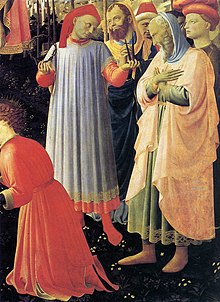Palla Strozzi
Palla di Noferi Strozzi | |
|---|---|
 Palla Strozzi (with nails) in the Deposition by Fra Angelico. | |
| Born | 1372 Florence |
| Died | 8 May 1462 Padova |
| Nationality | Florentine |
| Other names | Palla Strozzi Palla di Noferi Strozzi |
Palla di Onofrio Strozzi (1372 – 8 May 1462) was an Italian banker, politician, writer, philosopher and philologist.
Biography
He was born in Florence into the rich banking family of the Strozzi.[1] He was educated by humanists, learning Greek and Latin, and establishing an important collection of rare books. Vespasiano, in his Lives of illustrious men of the 15th century described him as rich, handsome, a family man, a scholar, and a great builder and collector.[2] Palla Strozzi was the richest man in Florence with a gross taxable assets of 162,925 florins in 1427,[3] including 54 farms, 30 houses, a banking firm with a capital of 45,000 florins, and communal bonds.[4] Despite his abundant wealth, Strozzi lived well beyond his means and had little interest in his family’s banking business, which would help lead to his eventual economic and political downfall in the later half of the 15th century.[1]
In his sixties, together with Rinaldo degli Albizzi, he became the leader of the opposition against Cosimo de' Medici, the man who practically controlled the political power in Florence. Initially successful, the two secured the imprisonment of Cosimo, forcing him into exile in 1433. However, when Cosimo returned, both the Strozzi and Albizzi families were exiled in turn. In 1434, Strozzi moved to Padua, where he started to plan a return to his native city. He was never able to return, though his son did and built a large palace in 1480.[1]
He died in 1462, leaving his collection to the Abbey of Santa Giustina. As patron of the arts, he was commissioner of Gentile da Fabriano's Adoration of the Magi in the Strozzi Chapel of Santa Trinita church in Florence. He additionally commissioned Fra Angelico's Deposition of Christ in the Sacristy of Santa Trinita in Florence.
His descendants settled in Ferrara.
See also
References
- ^ a b c Baldwin, Robert (2007). "GENTILE DA FABRIANO (c. 1390–1427): International Style and Court Culture" (PDF). Social History of Art, by Robert Baldwin.
- ^ Waters, W. G., and Emily Waters. The Vespasiano memoirs: lives of illustrious men of the 15th century. Toronto: University of Toronto Press in association with the Renaissance Society of America, 1997.
- ^ Crabb, Ann. The Strozzi of Florence: widowhood and family solidarity in the Renaissance. Ann Arbor: University of Michigan Press, 2000.
- ^ Brucker, Gene. Florence: the golden age, 1138–1737. University of California Press, 1998.
Sources
- Vannucci, Marcello (2006). Le grandi famiglie di Firenze. Newton &Compton. ISBN 88-8289-531-9.
